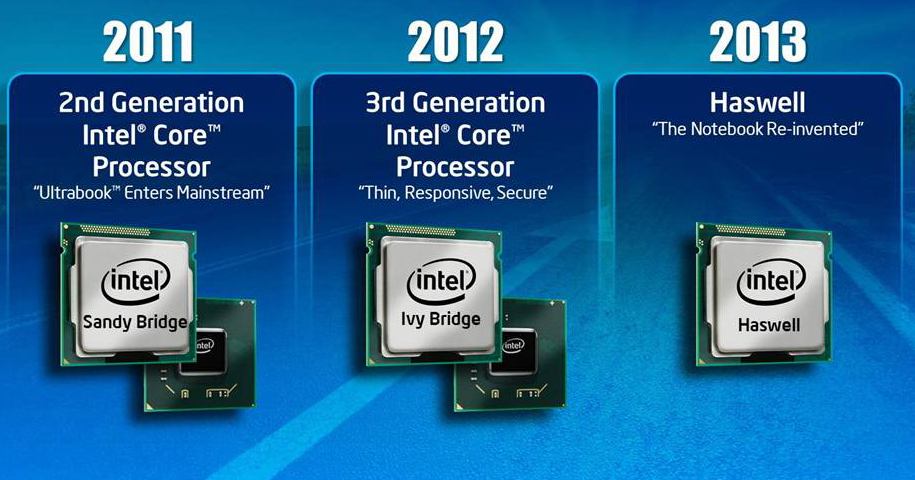Intel: Ultrabooks and tablets are on the way

Lately there have been a lot of stories about the slow start for Ultrabooks (here's my take). And Intel's long struggle to get into mobile devices is well-known. But better Ultrabooks and tablets are indeed coming. That was the key message out of the Intel Developer Forum in Beijing this week (the Webcasts are here).
Intel says there are already 21 different Ultrabooks available worldwide--all based on the 2nd Generation Core processors known as Sandy Bridge. Another 75 designs, based on the 3rd Generation Core chips, are in the works, Kirk Skaugen, the general manager of the PC group, said in a presentation. The first of these Ivy Bridge chips will reportedly launch on April 23.
This new wave of Ultrabooks will be available at prices starting at $699 by the end of this year. Though many of these will be traditional clamshell laptops, Intel is really emphasizing touchscreen and hybrid designs with Windows 8. During Skaugen's keynote, it gave a brief demo of an Ultrabook with a touchscreen running Windows 8 Consumer Preview to "dispel" the notion that touch experience isn't good on a clamshell and showed several convertibles including Intel prototypes, a Wistron design and Lenovo's Yoga.
"The Ultrabook is really a no-compromise personal computing experience," Skaugen said. "It is a tablet when you want it, and it is a notebook when you need it."
Typically when Intel does a shrink (in this case, from a 32nm process to a 22nm one), the performance gains are relatively minor. But with Ivy Bridge, Intel is promising a big boost from the HD 2500 and HD 4000 graphics. In particular, Intel is touting 70 percent better graphics performance than Sandy Bridge (there was a brief demo of a driving game) along with new features such as DirectX 11; support for up to three simultaneous displays; the ability to drive displays with resolutions as high as 2,560 by 1,600 pixels; and Quick Sync 2.0 for faster video encoding and playback.
Last week Intel released the 7-Series chipsets, which work with both Sandy Bridge and Ivy Bridge processors for laptops and desktops, along with a couple Intel-branded desktop motherboards. These are Intel's first chipsets that support USB 3.0 without a third-party controller. Intel is also pushing its Thunderbolt I/O technology, which is designed to carry both data and video, at speeds up to 10Gbps (by comparison, USB 3.0 has a theoretical speed of around 5Gbps). Though mainly known as a feature in Apple's Macs and 27-inch Thunderbolt Display, it is also available in a handful of peripherals from companies such as Belkin and LaCie. Skaugen said there will be about 100 Thunderbolt devices by the end of this year and "hundreds" in 2013.
While Ivy Bridge should bring a good leap in graphics performance and features, it is Haswell, the next microarchitecture, that Intel claims will deliver the "ultimate Ultrabook experience." Skaugen confirmed that Haswell was on track for release in 2013.
Intel hasn't provided as many details on its tablet plans, but later this year it will release a 1.8GHz Atom processor, code-named Clover Trail and manufactured on a 32nm process, designed for Windows 8 tablets. There are 10 companies currently designing tablets based on Intel's silicon and Windows 8. "You will probably see many, many Intel-based tablets in the market by the end of this year," said Sean Maloney, who heads up Intel China. Separately, Intel announced the Studybook, a 7-inch tablet designed for students and running either Android or Windows 7.
Intel is also aiming to get Atom into more smartphones. The first, the Lenovo K800, will be available in China in May. It is based on the Medfield platform with a 1.6GHz Atom Z2460. Intel plans to follow with a low-end version, the 1.0GHz Atom Z2000, and a high-end Atom Z2580, which will run at up to 1.8GHz and deliver twice the performance, according to Intel. Maloney said that ZTE is working on a "new generation" of Atom-based smartphones that will be shipping later this year, and Intel has previously announced a partnership with Motorola.
Intel is developing these Atom processors at a faster-than-usual cadence, illustrating the strategic importance of tablets and smartphones. The 22nm versions of these chips will ship sometime in 2013.
